Visiting The Sun Temple at Konark.
After a brief stay at Bhubaneshwar, I decided to travel to Konark Sun Temple which is 65 kms from Bhubaneshwar on Jan 2nd’07.I avoided going there on the New Year’s eve considering the multitude of tourists who would pour to visit, this World Heritage monument.
It was around 10 AM that I started my journey in a Maruti Alto, with my friend driving the car .It was a genuinely refreshing drive. In spite of the overindulgence on flight travels salving our national ‘every one no matter what gotta fly’ consumer cravings, the joys of the open road always beckoned me. I had made up my mind to throw off the demands of scheduling and speed, remain unplugged for two days completely and traverse the two-lane cheeky smooth Indian highways. It was a pleasant and relatively traffic-free ride along quiet tree-shaded lanes, only a little arduous towards the end because of the potholes and drive through the village amidst cattle.
Not many people were in sight on the route except, when nearing the village (near Konark), a boy tending a small herd of scraggy cows. The day was bright and sunny and we stood beside a well to drink some water, though dubiously colored liquid. The fifty or sixty huts and cottages that made up the village’s single straggling street, with their unevenly thatched grass roofs, low irregular mud walls and rough bamboo uprights, depressed me a little with their squalid appearance. A few inhabitants squat in the shade infront of their unattractive dwellings decorated on the exterior walls with cow dung cakes (used as fuel). A dark brown, sad woman with half-hidden shriveled breasts approached the well, stared at us and filled her earthen pitcher with water. When she was about to leave, I approached her for a pic and she acknowledged it.
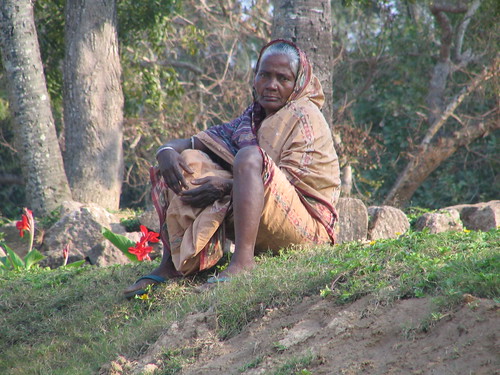
I find I have contracted the disease that infects most travelers and shutter bugs; life without a camera is like life sans breathes. And so have my camera wherever I go.
What immediately struck me on arriving at the site was the dramatic nature of the setting: the massive structure sitting in solitary grandeur surrounded by luxuriant gardens. A magnificent and imposing bulk of carefully carved black granite. The temple is dedicated to Sun God. Konark is also known as Konaditya. The name Konark is derived form the words Kona - Corner and Arka – Sun. Konark is also known as Arkakshetra.
I just couldn’t imagine the skills of the craftsmen at the time of building the temple. The temple is a magnificent piece of art and architecture. Different types of stone embroidery can be seen on the temple walls. Fantastic sculptures emerge out of the temple and make their mark. Beautiful figures are drawn and carved on whole of the temple top. The temple is also referred to as Black Pagoda (black since it is carved from black granite) and is also one of the sets of grand Indian temples.
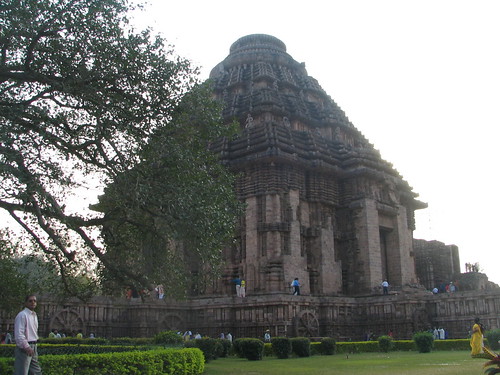
More history here and here.
The Konark Sun Temple is widely known for its architecture and artwork. It depicts the Orissian architectural art. Stretched across almost 2 kms of beach the temple makes it mark as the gigantic figure of art. The entire temple has been designed so as to look like a chariot of the sun god driven by Ganga and King Narasimha Deva. There are 24 wheels, which are each about 5 feet in radius. It also has a set of spokes and mesmerizing carvings. The temple is been dragged by seven horses. At the entrance there are two lions, which are like guards. There are also these crushing elephants, which are seen there.
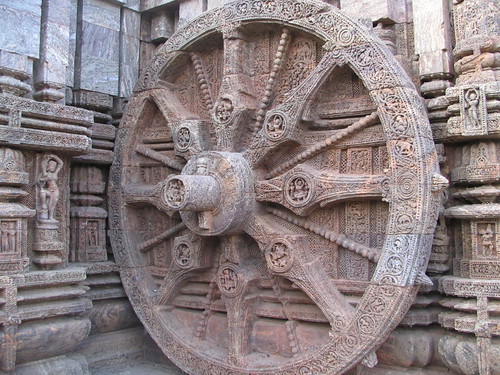
Steps lead to the main entrance of the temple. There are numerous complex carvings on the temple. There are beautiful animals carved on the temple. There are different types of warriors carved. The most attractive part of carvings is that of the Sun God. Mythological deities, beautiful flowers, battles, etc are some more types of carvings seen here. There are also some erotic style carvings done on the temple. Small carvings are also done with utmost care and intricate art.
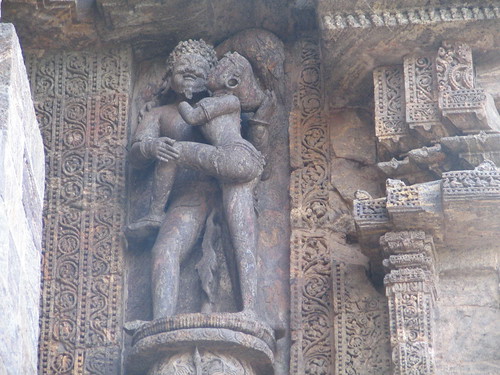
Some of the main parts of the temple are ruined. Wherever you go the beauty and art is different and unique. In front of the Jagmohana there is a Natya Mandir, which is also carefully carved with excellence. The best thing about the Konark Sun Temple is that most of its part has not been destroyed due to its age but because of the nature. It is now maintained by the Archeological Survey of India and it is an UNESCO World Heritage Site. Although they are doing a creditable job but nature is taking its toll, the hot moist air of the sea is constantly eroding the Temple at an alarming rate. Today the temple seems to be surrounded by a metallic cage. Metallic structure support parts of the temple, which are on the verge of collapsing.
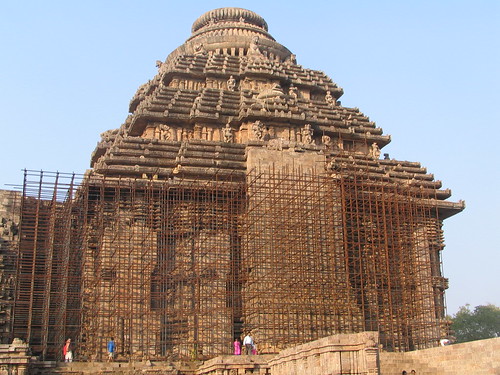
Very near to Konark is Pipili , known for its wall hangings, sunshades, lampshades and lot many other types of handicrafts. These handiworks are a must buy when one goes there, and with a little bit of bargaining you can really get the items for attractive prices.
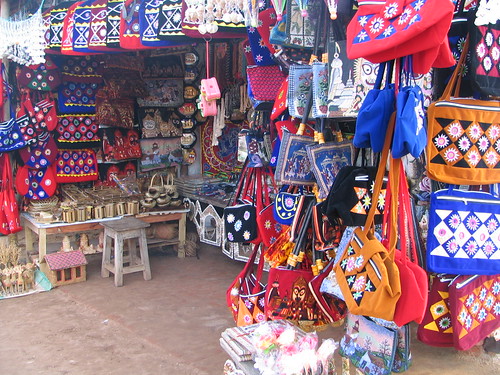
The entire structure is surrounded by lush green gardens and these are neatly maintained. With loads of tourists, many tourist hotels have come up and few of these are also managed by Orissa Tourism Department. There are tourists from all over India and also there are many foreign tourists too. The tour guides wait to pounce on a white-skinned person to make a few extra bucks. Since, I was there with my friend, later joined by a white skinned Swedish friend who was working on a project with UN, we had a tough time declining the flurry of requests from these tour guides. The ice broke when I started speaking in the local language "Oriya". Tender coconut, cucumber and local food in the series of small shops is a must try for the taste buds.

Few minutes before we left, we three (me, my Indian friend and my Swedish friend) were accosted by a family from Kolkata who wanted us to pose with them for a photo and then another with a family from the US. Soon after, it was a family from UP who seemed to be more interested in the presence of a foreigner at the site rather than in the site itself.
Located near the complex is the Konark Museum. It houses some of the sculpture removed from the temple including a reconstructed wheel. As not much can be done to prevent the temple from eroding away, the remaining pieces are being removed to the safe custody of the museum to save them from further damage.
Visiting Konark is like a trip back in time, a journey into the pages of history and an experience no historical book could ever provide. That’s why, the poet Rabindranath Tagore wrote of Konark: "here the language of stone surpasses the language of man". After having visited the site, I now know what he meant. Words could never do it justice. The endless routine of life and ordinariness of driving there for hours was rewarded by the high drama and extraordinariness of what must be one of the best human-made sites the world has to offer.
Don’t miss the pics. Album here.
Visit it once and you can know its grandeur, brilliance and splendor. Its poetry on stone. My tip visit the place between November and February, i.e. (the winter months)
Keep reading and remain connected.

0 Comments:
Post a Comment
<< Home